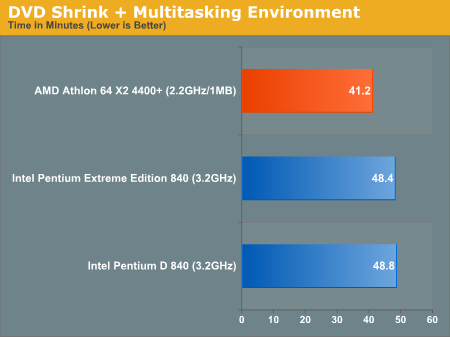Multitasking Scenario 5: Compiling
Our final non-gaming multitasking scenario is quite possibly our most strenuous. It involves the following background tasks: iTunes playing a playlist, Firefox with the same 13 tabs open as in our other tests, and Newsleecher updating newsgroup headers. On top of those tasks, we compiled Firefox as well as ran our DVD Shrink operation on the "Star Wars Episode VI" DVD. Firefox remained the application in focus during the test.
The results were fairly interesting. First, let's look at how long it took us to compile Firefox:

The Athlon 64 X2 4400+ was stronger than either of the Intel CPUs in compiler performance, so it is no surprise that it is faster here. You'll notice that the single core Athlon 64 FX-55 isn't present in this chart - you'll find out why in a moment, but first, let's look at the performance of our DVD Shrink task that also ran in the background:

Once again, AMD is ahead of the competition, thanks to better general performance as well as all of the benefits of their low latency architecture. As for why the single core Athlon 64 FX-55 wasn't included here, well in this particular test, the DVD Shrink operation would have taken over 13 hours - which doesn't exactly fit with our graph's scale. The compiler operation also took significantly longer to complete. Whichever task completed first would eventually have let the other finish sooner, but we didn't care to find out as it was already ridiculously longer than any of the dual core solutions.












144 Comments
View All Comments
Phlargo - Thursday, April 21, 2005 - link
Sounds like computing could change a lot in the next 6 months.I can't wait to get my hands on a dual core chip - that type of multitasking gaming performance is what I've been waiting for... 92% of unfettered performance during Doom3? That's unbelievable.
manno - Thursday, April 21, 2005 - link
Another thing to consider is that the 939, and 940 Dual Cores work with old mobos. so that saves upgraders ~$100 for the mobo (I have no clue what PD mobo's are going to cost) plus the cost of DDR2 ~$100 for 512MB, not true if you're going with the PD. So if you own a 939 a 2.8 PD will realy cost you ~$441, 3.0 -$516, 3.2 ~$730.Throw that out the window if you're starting from scratch however.
manno - Thursday, April 21, 2005 - link
Great review very detailed, I have one caveat, and I should preface it with the fact that I own 4 systems, and all of them have Athlon 64's or XP's.That being said your "Multitasking Scenario 2: File Compression" Seems to be misleading, and identifies the A64 as the processor of choice in the 2nd portion of the analysis.
Maybe I'm wrong but from what I understand with how the test was performed you archived the file, got the amount of time it took to archive the file "x" for instance, and then figured out how many emails got imported in time "x" now because some processors took longer to create the archive than others they had more time to import emails. so in order to make this data more reflective of the performance of each processor you need to divide the number of emails imported by "x", and get e/s. The modified graph should be
PD 3.2 =19124/5.08 or 3764.57 e/s
A64 X2 =21687/6.25 or 3469.92 e/s
PEE 3.2 =16875/6.65 or 2537.59 e/s
AFX 55 = 3800/5.88 or 646.26 e/s
These corrected numbers show that at least in this test the PD 3.2 is the winner by ~8%
-manno
Calin - Thursday, April 21, 2005 - link
At that prices, most of the users really won't need their current mainboards for new dual core processors. I would prefer to have lower priced single core than that prices on dual core.blckgrffn - Thursday, April 21, 2005 - link
We are talking about by this fall, folks. And a 90nm Dual core still uses LESS die than 2 2800+ put together because it is on a manufacturing smaller process, especially if they stick to a 512k cache which is obviously the sweet spot. By this fall I expect that we will see sub $200 dual cores from Intel to squeeze AMD on the desktop market. What is a real shame is that AMD doesn't have suffcient fabs to handle potential demand.For those of you who got all hot in your pants and said I can't buy a sub $200 dual core Intel right now, it is just as true that I can't buy one it all! ;P Chill!
PeteRoy - Thursday, April 21, 2005 - link
Impressive.josedawg - Thursday, April 21, 2005 - link
Am I mistaken in thinking that AMD was throwing out their desktop dualcore line (A64 X2) in 2006? What prompted their earlier release of them? Was it the demand for desktop dualcore, pressure from Intel stealing desktop dualcore market, or excellent manufacturing at the AMD plants?KeithDust2000 - Thursday, April 21, 2005 - link
blckgrffn, "so if they can't bring anything out under $200 I will probably have to go with Intel. Boo for that ;) "INTEL doesn´t have one under $200 either.
Jeff7181 - Thursday, April 21, 2005 - link
#14... all socket 939 motherboards will support the X2 with a BIOS upgdate.Zebo - Thursday, April 21, 2005 - link
#9 They'd have to release a 1.6 @ $240 to accurately compete with Intels slowness in Pentium D's starting at $241. Sorry not gonna happen. AMD not for budget shoppers anymore but those interested in performance. Want the best? Pay the price. Or substandard CPU at a discount?I can see a 1.8 for about $250 though however no way you're going to get into DC for less than $200.